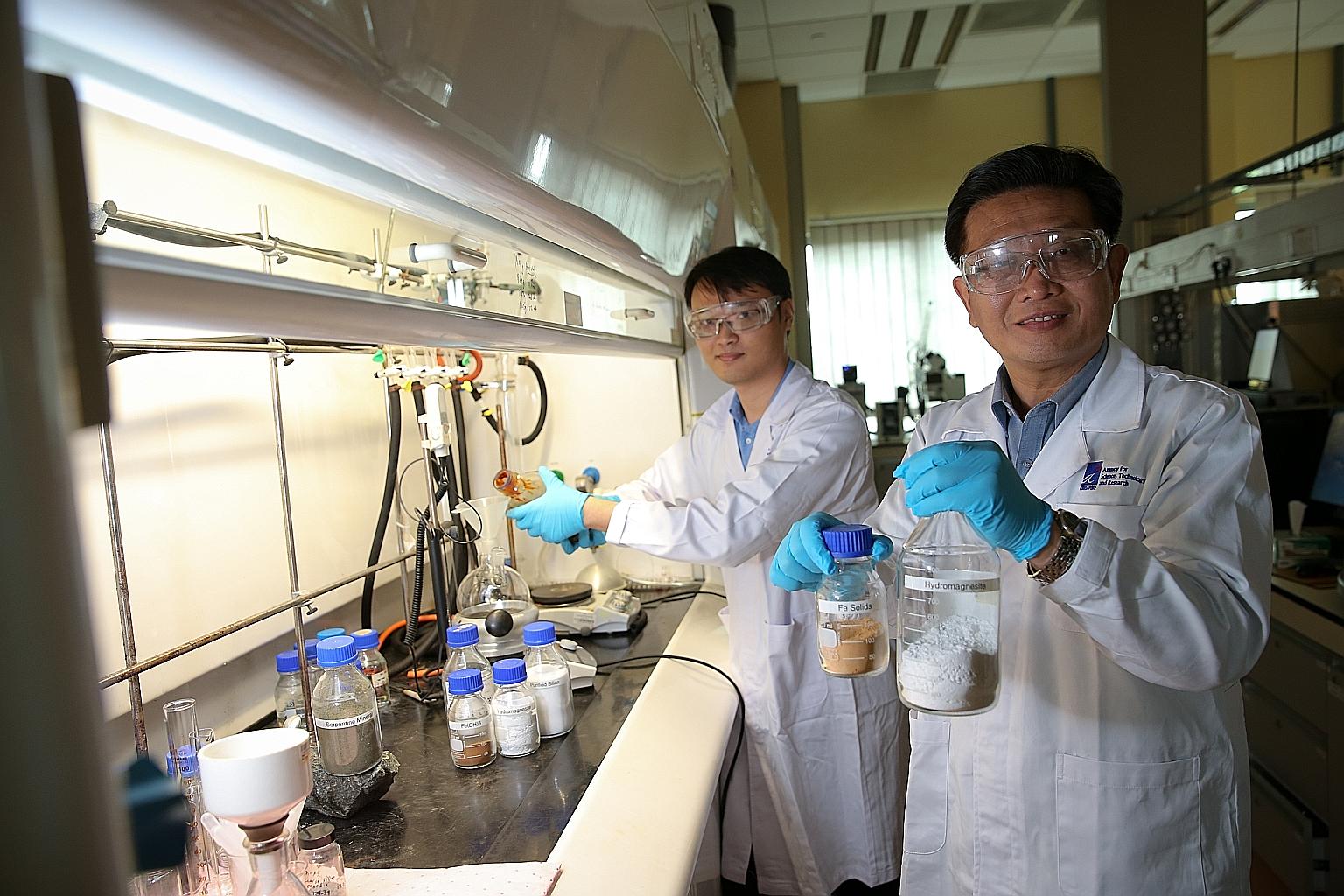S'pore-designed device 'aids climate change war'
CO2 given off by power stations would be captured and converted to harmless minerals for use in land reclamation
Sign up now: Get ST's newsletters delivered to your inbox

Dr Bu Jie (right) and senior research engineer Yeo Tze Yuen are among the A*Star scientists working on the new carbon dioxide conversion process. Dr Bu said: "It's one stone, two birds... We can reduce carbon dioxide from anywhere, and get construction material to adapt to climate change..."
ST PHOTO: ONG WEE JIN
Lin Yangchen
Follow topic:
Scientists here are designing a machine to capture carbon dioxide given off by power stations and convert it to harmless minerals that can be used for land reclamation.
The team, from the Agency for Science, Technology and Research's (A*Star) Institute of Chemical and Engineering Sciences (ICES), hopes to scale it up to levels of carbon dioxide conversion that will make a difference in the climate change fight.
Dr Bu Jie, the team leader, said: "It's one stone, two birds...We can reduce carbon dioxide from anywhere, and get construction material to adapt to climate change..."
Their work is timely, as the Centre for Climate Research Singapore has projected in its Second National Climate Change Study that the average temperature here may increase by up to 4.6 deg C by the end of the century, and the sea level could rise by up to a metre if no action is taken.
Dr Bu said it would be difficult for Singapore to cut its carbon dioxide emissions by improving its methods of electricity generation because more than 90 per cent of the electricity here is already coming from relatively clean natural gas.
Singapore also has limited options for renewable energy, besides solar power. There is no space for other renewable energy options like hydroelectric or wind power.
One other way, then, to stop carbon dioxide going into the atmosphere is to convert it back to something inert, such as mineral carbonates, in which the carbon dioxide is bonded to another element. Research published in 2003 in the journal Science identified mineral carbonates as having the greatest carbon storage capacity and longevity, more so than methods like underground injection of carbon dioxide.
ICES' latest technique reacts carbon dioxide with serpentine, a globally abundant rock composed mainly of magnesium, iron and silica. The product of the reaction is a mix of mainly magnesium carbonate, silica and iron oxide that can be used in land reclamation.There is minimal wastage as one tonne of carbon dioxide and three tonnes of serpentine would yield four tonnes in reclamation materials.
The real power of the method lies in the ability to do the conversion without using high pressure and temperature. In fact, normal atmospheric pressure and 50 deg C will do, and the researchers are trying to get it down to room temperature.
They have secured two patents to date and are working on publishing their latest findings.
Part of the trick is to first grind the serpentine into a fine powder and dissolve the carbon dioxide in ammonia solution, which can be reused. Alas, the serpentine has to be pretreated at about 650 deg C to get rid of water from its microscopic pores. Although one could use a power plant's waste heat for this, the researchers are exploring the use of recyclable chemicals instead.
The process, which costs about $500, emits a tonne of carbon dioxide for every two tonnes captured. The researchers are trying to bring the cost down to $200.
They are now designing a pilot unit that can convert 100 kilotonnes of carbon dioxide a year. Because the conversion takes place at normal pressure, it is potentially easy to scale up, said co-researcher Naraharisetti Pavan Kumar.
This is important because climate and land reclamation benefits come only when huge amounts of carbon dioxide are converted. For example, one million tonnes of carbon dioxide translate to about 8ha of land, the size of eight football fields. And about 25 million tonnes are needed to build a 10m-wide seawall that raises Singapore's 200km coastline by 5m, said Dr Bu.
The scientists hope to eventually license their technology to other countries in the Asia-Pacific. Already they are in a partnership with an Australian mining firm that provides serpentine and financial support.
Dr Paul Sharratt, ICES' head of process science and modelling, said the team would welcome collaboration with other research institutions because of the many different sources of carbon dioxide, from refineries to power stations fed by different kinds of fossil fuels, that require slightly different methods of carbon dioxide conversion.
"There isn't a one-size-fits-all solution...There's such a need for a range of technologies that nobody's going to get all of it right."
A spokesman for the National Climate Change Secretariat said the technology could potentially help Singapore cut carbon emissions, but it is not yet mature enough for practical use. She added that the agency will continue to work with researchers to develop low-carbon technologies to tackle climate and sustainability challenges.

